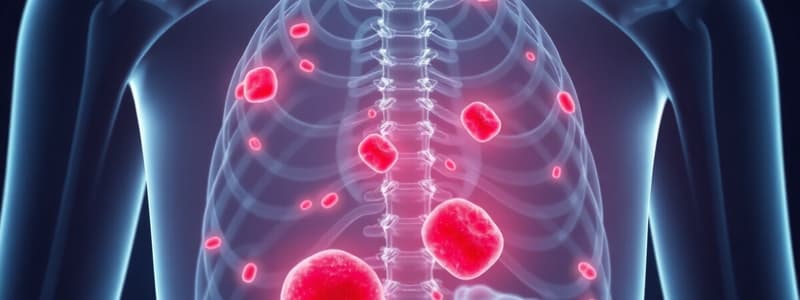Podcast
Questions and Answers
Define aplastic anemia and describe its primary clinical feature.
Define aplastic anemia and describe its primary clinical feature.
Aplastic anemia is a bone marrow failure syndrome characterized by peripheral pancytopenia, which is a decrease in red blood cells, white blood cells, and platelets.
List at least three congenital causes of aplastic anemia.
List at least three congenital causes of aplastic anemia.
Three congenital causes include Fanconi anemia, Dyskeratosis congenita, and Diamond-Blackfan anemia.
What role does autoimmune T-cell activity play in aplastic anemia?
What role does autoimmune T-cell activity play in aplastic anemia?
Autoimmune T-cell activity is suggested to be a mediating factor in the primary (idiopathic) form, contributing to the destruction of hematopoietic stem cells.
How can Fanconi anemia be diagnosed in patients?
How can Fanconi anemia be diagnosed in patients?
Differentiate between the primary (idiopathic) and secondary causes of aplastic anemia.
Differentiate between the primary (idiopathic) and secondary causes of aplastic anemia.
What are the common lab features seen in patients with aplastic anemia?
What are the common lab features seen in patients with aplastic anemia?
What is the typical treatment approach for Fanconi anemia?
What is the typical treatment approach for Fanconi anemia?
Explain why patients with aplastic anemia are at risk for myelodysplastic syndromes or acute myeloid leukemia.
Explain why patients with aplastic anemia are at risk for myelodysplastic syndromes or acute myeloid leukemia.
Describe the age range typically associated with the presentation of Fanconi anemia.
Describe the age range typically associated with the presentation of Fanconi anemia.
What impact do congenital defects have on patients with aplastic anemia?
What impact do congenital defects have on patients with aplastic anemia?
What are the key differences between inevitable and idiosyncratic aplastic anemia caused by cytotoxic drugs?
What are the key differences between inevitable and idiosyncratic aplastic anemia caused by cytotoxic drugs?
Describe the common clinical features associated with aplastic anemia.
Describe the common clinical features associated with aplastic anemia.
What is the role of immune mechanisms in the pathogenesis of aplastic anemia?
What is the role of immune mechanisms in the pathogenesis of aplastic anemia?
Identify the viruses commonly associated with aplastic anemia and their effect on patients.
Identify the viruses commonly associated with aplastic anemia and their effect on patients.
What laboratory investigations are essential for diagnosing aplastic anemia?
What laboratory investigations are essential for diagnosing aplastic anemia?
Explain how PNH differs from other causes of bone marrow failure.
Explain how PNH differs from other causes of bone marrow failure.
What is the relationship between aplastic anemia and autoimmune diseases?
What is the relationship between aplastic anemia and autoimmune diseases?
Discuss the potential genetic factors implicated in aplastic anemia.
Discuss the potential genetic factors implicated in aplastic anemia.
What is the significance of reticulocyte count in the evaluation of aplastic anemia?
What is the significance of reticulocyte count in the evaluation of aplastic anemia?
How can immunosuppressive therapy aid in the management of aplastic anemia?
How can immunosuppressive therapy aid in the management of aplastic anemia?
Flashcards are hidden until you start studying
Study Notes
Aplastic Anemia
- Definition: A bone marrow failure syndrome characterized by peripheral pancytopenia and marrow hypoplasia.
- Pathogenesis: Involves either a single cell line or all myeloid lineages due to defects in hematopoietic stem cells.
- Etiologies:
- Congenital/Inherited (20%):
- Fanconi anemia (FA): Autosomal recessive, associated with growth retardation, congenital defects, chromosomal breakage.
- Dyskeratosis congenita (DC): Manifestations include skin abnormalities, nail dystrophy, mucosal lesions.
- Diamond–Blackfan anaemia (DBA): Pure red cell aplasia, often diagnosed in infancy.
- Shwachman-Diamond syndrome (SDS): Characterized by pancreatic insufficiency, skeletal abnormalities.
- Familial aplastic anemia: Family history of aplastic anemia.
- Severe congenital neutropenia: Marked decrease in neutrophils.
- Acquired (80%):
- Primary (Idiopathic): Most common form, likely autoimmune in origin.
- Secondary (Causes):
- Ionizing radiation: Accidental or therapeutic (radiotherapy).
- Drugs:
- Marrow depressants: Busulfan, melphalan, cyclophosphamide, etc.
- Occasional/Rare causes: Chloramphenicol, sulphonamides, gold, etc.
- Chemicals: Benzene, organophosphates, pesticides.
- Viruses: Hepatitis, EBV, Herpes simplex, Parvovirus.
- Autoimmune diseases: SLE, RA.
- Transfusion associated GVHD.
- Thymoma.
- Malignancies: AML, ALL, MDS.
- Pregnancy.
- Congenital/Inherited (20%):
- Potential Mechanisms:
- Absent or defective stem cells.
- Abnormal marrow micro-environment.
- Inhibition by an abnormal clone of hematopoietic cells.
- Abnormal regulatory cells or factors.
- Immune-mediated suppression of hematopoiesis.
- Genetic predisposition: Higher incidence with HLA (II) histocompatibility Antigen.
- Immune mechanism: Autoreactive T-cells, intrinsic stem cell defects, and/or immune suppression.
- Forms:
- Inevitable: Dose-related, e.g., cytotoxic drugs, ionizing radiation.
- Idiosyncratic: Unpredictable, e.g., anti-inflammatory antibiotics, anti-epileptic medications.
- Common Traits:
- Aplasia from any origin may recover after immunosuppressive therapy, implying immune involvement.
- Transition to a clonal disorder of hemopoiesis can occur in any patient who has recovered bone marrow function, suggesting hematopoietic system fragility.
- Clinical Features:
- Anemia: Pallor, tachycardia, fatigue, dizziness, shortness of breath.
- Thrombocytopenia: Bruising, bleeding gums, epistaxis, menorrhagia, retinal hemorrhage.
- Neutropenia: Infections, particularly of the mouth, throat, skin, lungs, and sepsis.
- Jaundice and hepatitis: In some patients.
- Lymph nodes, liver, and spleen are not enlarged.
- Clinical Features (Inherited Marrow Failure Syndromes):
- Physical stigmata: Skin pigmentation, short stature, microcephaly, hypogonadism, mental retardation, skeletal anomalies.
- Investigations:
- Complete Blood Count (CBC): To assess anemia, thrombocytopenia, and neutropenia.
- Reticulocyte count: To evaluate erythropoiesis.
- Blood film: To assess red cell morphology and presence of blasts.
- Liver function tests: To assess potential liver involvement.
- Virology: To look for viral causes.
- Bone marrow aspirate & trephine biopsy: To confirm marrow hypoplasia and assess cellularity.
- Tests to distinguish AA from PNH: Ham's test, CD55,59 assay.
- Cytogenetic analysis: For congenital types.
Paroxysmal Nocturnal Hemoglobinuria (PNH)
- Definition: A rare, acquired clonal disorder of marrow stem cells deficient in the glycosylphosphatidylinositol (GPI) anchor.
- Clinical triad: Chronic intravascular hemolysis, venous thrombosis, and bone marrow failure.
- Pathogenesis: Lack of DAF (CD55) and MIRL (CD59) renders red cells sensitive to complement-mediated lysis.
- Diagnosis:
- Ham's test (acid hemolycin test): Positive result indicates increased RBC fragility.
- CD55,59 assay using flow cytometry: Shows deficient RBC populations.
- Treatment: Eculizumab (Soliris).
Lab findings:
- Anemia with reticulocytopenia
- Thrombocytopenia
- Neutropenia
- Elevated LDH (lactate dehydrogenase)
- Hypoalbuminemia
- Increased bilirubin
- Bone marrow aspiration and biopsy essential
Studying That Suits You
Use AI to generate personalized quizzes and flashcards to suit your learning preferences.




